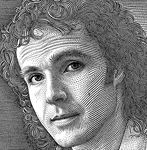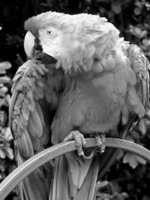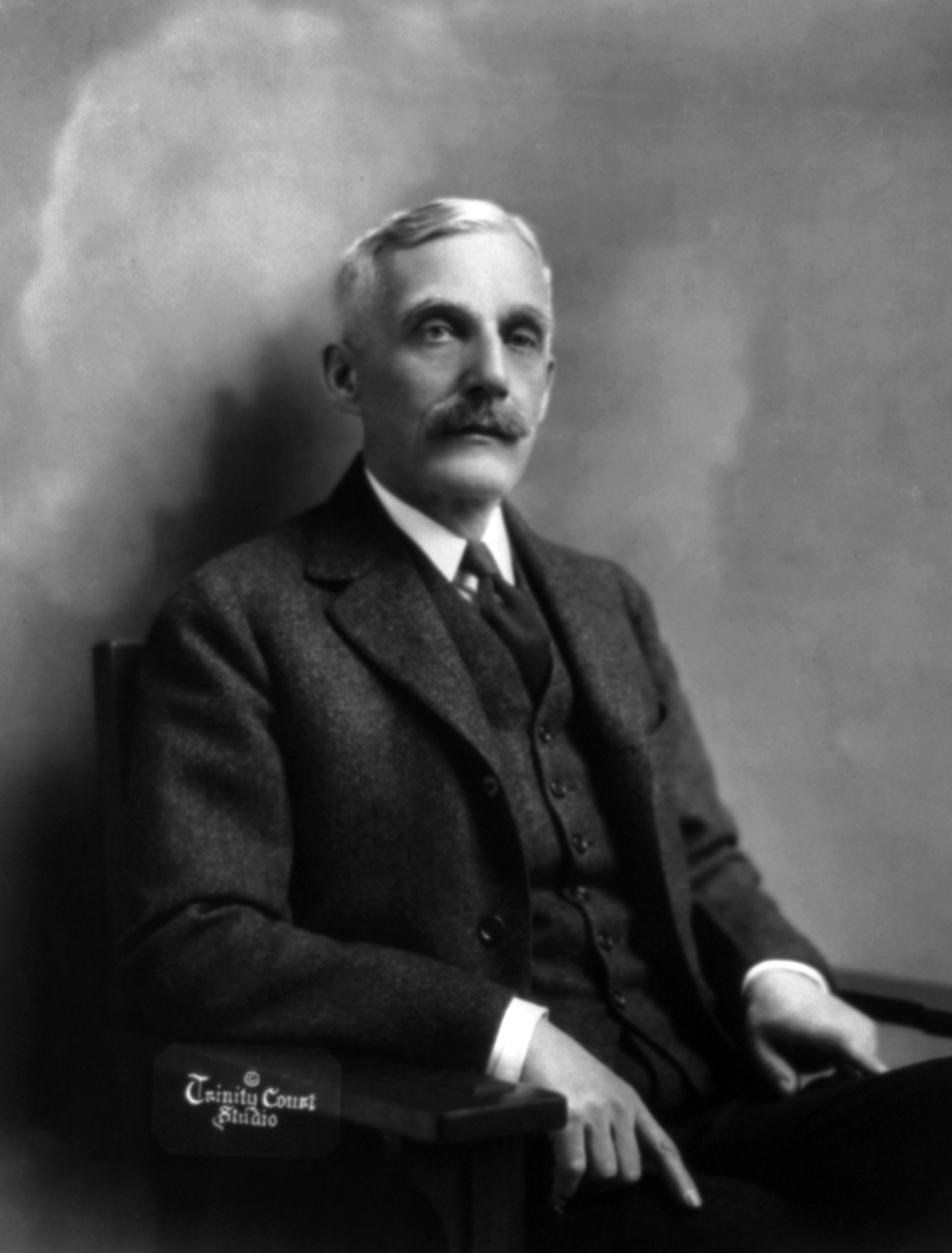|
Hedcut
Hedcut is a term referring to a style of drawing associated with ''The Wall Street Journal'' half-column portrait illustrations. The newspaper staff uses the stipple method of many small dots and the hatching method of small lines to create an image, and are designed to emulate the look of woodcuts from old-style newspapers, and engravings on certificates and currency. The phonetic spelling of "hed" may be based on newspapers' use of the term ''hed'' for "headline". ''The Wall Street Journal'' adopted the current form of this portraiture in 1979 when freelance artist Kevin Sprouls approached the paper with some ink-dot illustrations he had created. The front-page editor felt that the drawings complemented the paper's classical feeling and gave it a sense of stability. Additionally, they are generally more legible than photographs of the same size would be. Sprouls was subsequently hired as a staff illustrator and remained there until 1987. Today, there are five hedcut artist ... [...More Info...] [...Related Items...] OR: [Wikipedia] [Google] [Baidu] |
Kevin Sprouls
Kevin Sprouls is the creator of the ''Wall Street Journal portrait'' style known as ''hedcut.'' He began as a freelance illustrator for Dow Jones and Company, the parent company for ''The Wall Street Journal.'' In 1979 he introduced a style of stipple portraiture that the ''Journal'' adopted because it was reminiscent of the sort of old engravings that are found on bank notes.Dawson, V. (2004, 07). Ink dot art. ''Smithsonian, 55'', 40. Retrieved from Proquest. Kevin became the first full-time artist at the ''Journal,'' eventually the Assistant Art Director and head of the illustration department. His ''Wall Street Journal'' stipple illustrations were awarded a gold medal at ''The Society of Illustrators'' competition in 1986. His style of portraiture, later coined ''hedcut,'' is the definitive corporate icon and is created completely by hand, not computer. Sprouls is once again a freelance artist but still works for ''Dow Jones'' on occasion, along with a host of other publi ... [...More Info...] [...Related Items...] OR: [Wikipedia] [Google] [Baidu] |
The Wall Street Journal
''The Wall Street Journal'' (''WSJ''), also referred to simply as the ''Journal,'' is an American newspaper based in New York City. The newspaper provides extensive coverage of news, especially business and finance. It operates on a subscription model, requiring readers to pay for access to most of its articles and content. The ''Journal'' is published six days a week by Dow Jones & Company, a division of News Corp. As of 2023, ''The'' ''Wall Street Journal'' is the List of newspapers in the United States, largest newspaper in the United States by print circulation, with 609,650 print subscribers. It has 3.17 million digital subscribers, the second-most in the nation after ''The New York Times''. The newspaper is one of the United States' Newspaper of record, newspapers of record. The first issue of the newspaper was published on July 8, 1889. The Editorial board at The Wall Street Journal, editorial page of the ''Journal'' is typically center-right in its positio ... [...More Info...] [...Related Items...] OR: [Wikipedia] [Google] [Baidu] |
Drawing
Drawing is a Visual arts, visual art that uses an instrument to mark paper or another two-dimensional surface, or a digital representation of such. Traditionally, the instruments used to make a drawing include pencils, crayons, and ink pens, sometimes in combination. More modern tools include Stylus (computing), computer styluses with graphics tablets and gamepads in Virtual reality, VR drawing software. A drawing instrument releases a small amount of material onto a surface, leaving a visible mark. The most common support for drawing is paper, although other materials, such as Paperboard, cardboard, vellum, wood, plastic, leather, canvas, and Lumber, board, have been used. Temporary drawings may be made on a blackboard or whiteboard. Drawing has been a popular and fundamental means of public expression throughout human history. It is one of the simplest and most efficient means of communicating ideas. The wide availability of drawing instruments makes drawing one of the most comm ... [...More Info...] [...Related Items...] OR: [Wikipedia] [Google] [Baidu] |
Stippling
Stippling is the creation of a pattern simulating varying Grayscale, degrees of solidity or shading by using small dots. Such a pattern may occur in nature and these effects are frequently emulated by artists. Art In printmaking, stipple engraving is a technique using flicks of the burin to build up the image in short lines or dots, often combined with conventional linear engraving. In engraved glass a similar stipple technique has often been popular. In a drawing or painting, the dots are made of pigment of a single colour, applied with a pen or brush; the denser the dots, the darker the apparent shade—or lighter, if the pigment is lighter than the surface. This is similar to—but distinct from—pointillism, which uses dots of different colours to simulate blended colours. Botany In description of flora species, a stippling is a kind of pattern, especially in the case of flowering plants, produced in nature that occur on flower petals and sepals. These are similar ... [...More Info...] [...Related Items...] OR: [Wikipedia] [Google] [Baidu] |
Hatching
Hatching () is an artistic technique used to create tonal or shading effects by drawing (or painting or scribing) closely spaced parallel lines. When lines are placed at an angle to one another, it is called cross-hatching. Hatching is also sometimes used to encode colours in monochromatic representations of colour images, particularly in heraldry. Hatching is especially important in essentially linear media, such as drawing, and many forms of printmaking, such as engraving, etching and woodcut. In Western art, hatching originated in the Middle Ages, and developed further into cross-hatching, especially in the old master prints of the fifteenth century. Master ES and Martin Schongauer in engraving and Erhard Reuwich and Michael Wolgemut in woodcut were pioneers of both techniques, and Albrecht Dürer in particular perfected the technique of crosshatching in both media. Artists use the technique, varying the length, angle, closeness and other qualities of the lines, ... [...More Info...] [...Related Items...] OR: [Wikipedia] [Google] [Baidu] |
Woodcut
Woodcut is a relief printing technique in printmaking. An artist carves an image into the surface of a block of wood—typically with gouges—leaving the printing parts level with the surface while removing the non-printing parts. Areas that the artist cuts away carry no ink, while characters or images at surface level carry the ink to produce the print. The block is cut along the wood grain (unlike wood engraving, where the block is cut in the end-grain). The surface is covered with ink by rolling over the surface with an ink-covered roller ( brayer), leaving ink upon the flat surface but not in the non-printing areas. Multiple colours can be printed by keying the paper to a frame around the woodblocks (using a different block for each colour). The art of carving the woodcut can be called ''xylography'', but this is rarely used in English for images alone, although that term and ''xylographic'' are used in connection with block books, which are small books containing text ... [...More Info...] [...Related Items...] OR: [Wikipedia] [Google] [Baidu] |
Grayscale
In digital photography, computer-generated imagery, and colorimetry, a greyscale (more common in Commonwealth English) or grayscale (more common in American English) image is one in which the value of each pixel is a single sample (signal), sample representing only an ''amount'' of light; that is, it carries only luminous intensity, intensity information. Grayscale images, are black-and-white or gray monochrome, and composed exclusively of shades of gray. The contrast (vision), contrast ranges from black at the weakest intensity to white at the strongest. Grayscale images are distinct from one-bit bi-tonal black-and-white images, which, in the context of computer imaging, are images with only two colors: black and white (also called ''bilevel'' or ''binary images''). Grayscale images have many shades of gray in between. Grayscale images can be the result of measuring the intensity of light at each pixel according to a particular weighted combination of frequencies (or wavelen ... [...More Info...] [...Related Items...] OR: [Wikipedia] [Google] [Baidu] |
Photoshop
Adobe Photoshop is a raster graphics editor developed and published by Adobe for Windows and macOS. It was created in 1987 by Thomas and John Knoll. It is the most used tool for professional digital art, especially in raster graphics editing, and its name has become genericised as a verb (e.g. "to photoshop an image", " photoshopping", and " photoshop contest") although Adobe disapproves of such use. Photoshop can edit and compose raster images in multiple layers and supports masks, alpha compositing and several color models. Photoshop uses its own PSD and PSB file formats to support these features. In addition to raster graphics, Photoshop has limited abilities to edit or render text and vector graphics (especially through clipping path for the latter), as well as 3D graphics and video. Its feature set can be expanded by plug-ins; programs developed and distributed independently of Photoshop that run inside it and offer new or enhanced features. Photoshop's naming sch ... [...More Info...] [...Related Items...] OR: [Wikipedia] [Google] [Baidu] |
Pica (typography)
The pica is a typographic unit of measure corresponding to approximately of an inch. One pica is further divided into 12 Point (typography), points. In printing, three pica measures are used: * The French pica of 12 Didot points (also called Cicero (typography), cicero) generally is: 12 × 0.376 = . * The American pica of . It was established by the United States Type Founders' Association in 1886. In TeX one pica is of an inch. * The contemporary computer PostScript pica is exactly of an inch, i.e. 0.1 in or 4.2 mm. Publishing applications such as Adobe InDesign and QuarkXPress represent pica measurements with whole-number picas left of a lower-case ''p'', followed by the points number, for example: 5p6 represents 5 picas and 6 points, or 5 picas. Cascading Style Sheets (CSS) defined by the World Wide Web Consortium use pc as the abbreviation for pica ( of an inch), and pt for point ( of an inch). The pica is also used in measuring the font capacity and is applied in the ... [...More Info...] [...Related Items...] OR: [Wikipedia] [Google] [Baidu] |
Smithsonian Institution
The Smithsonian Institution ( ), or simply the Smithsonian, is a group of museums, Education center, education and Research institute, research centers, created by the Federal government of the United States, U.S. government "for the increase and diffusion of knowledge". Founded on August 10, 1846, it operates as a trust instrumentality and is not formally a part of any of the Federal government of the United States#branches, three branches of the federal government. The institution is named after its founding donor, British scientist James Smithson. It was originally organized as the United States National Museum, but that name ceased to exist administratively in 1967. The Smithsonian Institution has historical holdings of over 157 million items, 21 museums, 21 libraries, 14 education and research centers, a zoo, and historical and architectural landmarks, mostly located in Washington, D.C. Additional facilities are located in Maryland, New York (state), New York, and Virg ... [...More Info...] [...Related Items...] OR: [Wikipedia] [Google] [Baidu] |
National Portrait Gallery (United States)
The National Portrait Gallery (NPG) is an art museum in Washington, D.C., United States. Founded in 1962 and opened in 1968, it is part of the Smithsonian Institution. Its collections focus on images of American artists, politicians, scientists, inventors, activists, and performers who have contributed to the nation's history, development, and culture. Along with the Smithsonian American Art Museum, the museum is housed in the historic Old Patent Office Building. History Founding of the museum The first portrait gallery in the United States was Charles Willson Peale's ''American Pantheon'', also known as ''Peale's Collection of Portraits of American Patriots'', established in 1796. It closed after two years. In 1859, the National Portrait Gallery, London, National Portrait Gallery in London opened, but few Americans took notice.Thompson, Bob. "Who Gets Into the National Portrait Gallery, and Why?" ''Washington Post''. June 13, 1999. The idea of a federally owned national portr ... [...More Info...] [...Related Items...] OR: [Wikipedia] [Google] [Baidu] |





